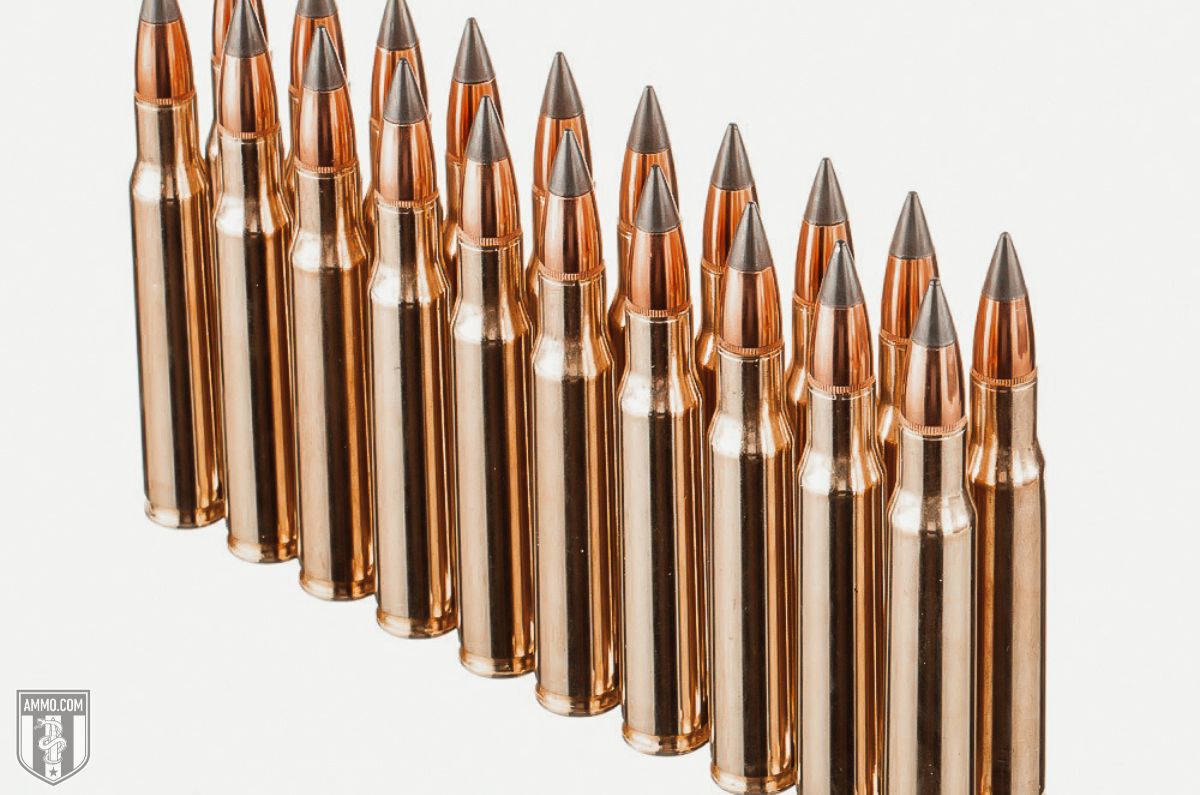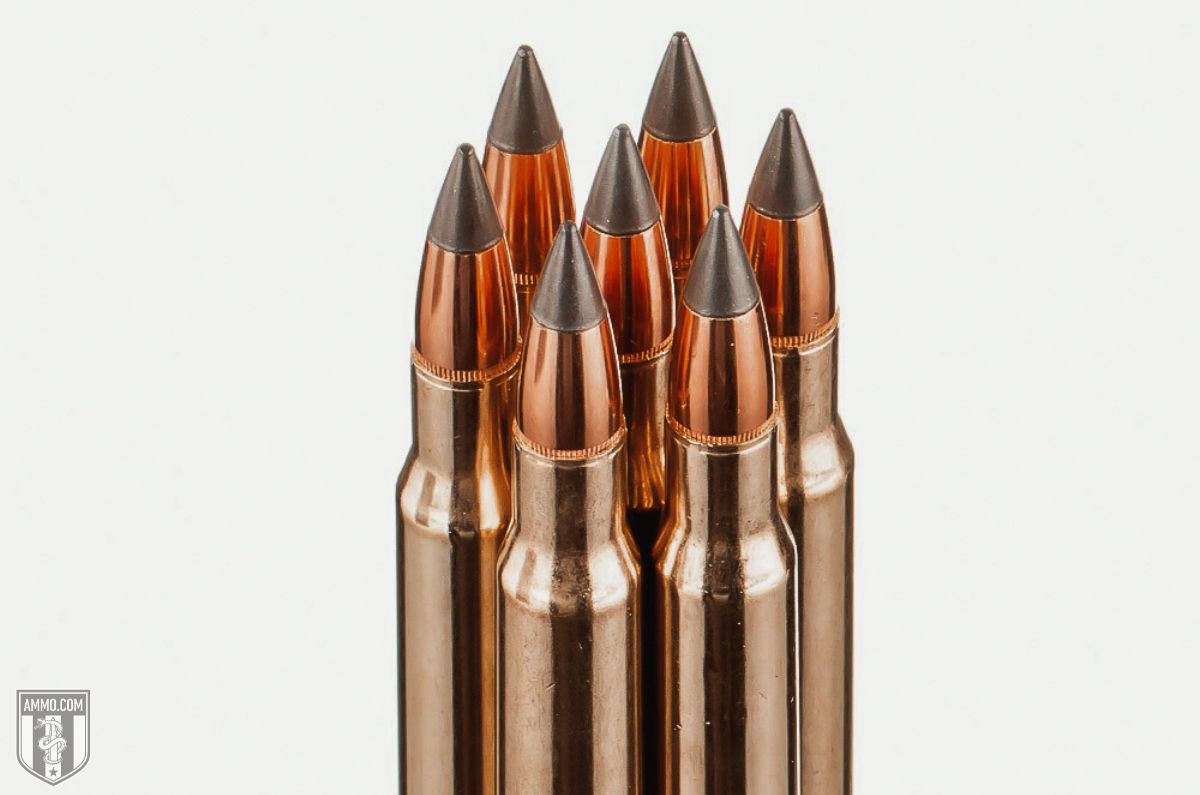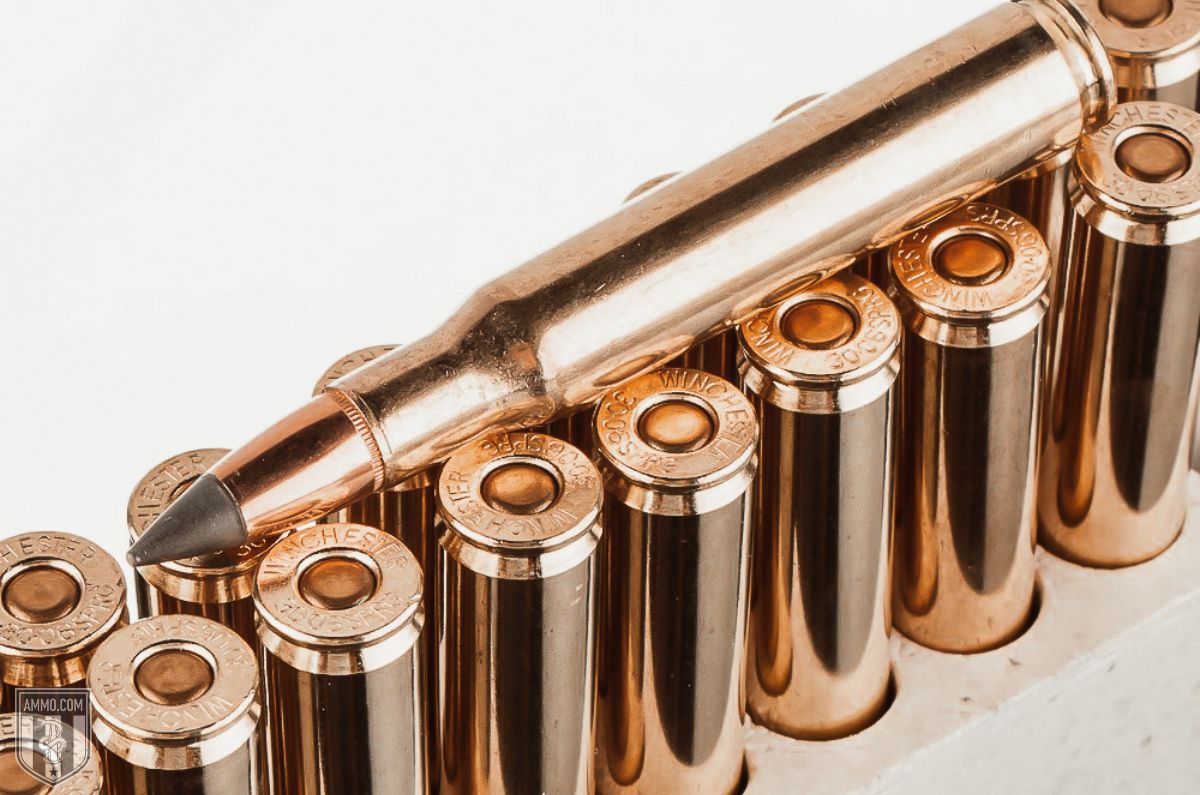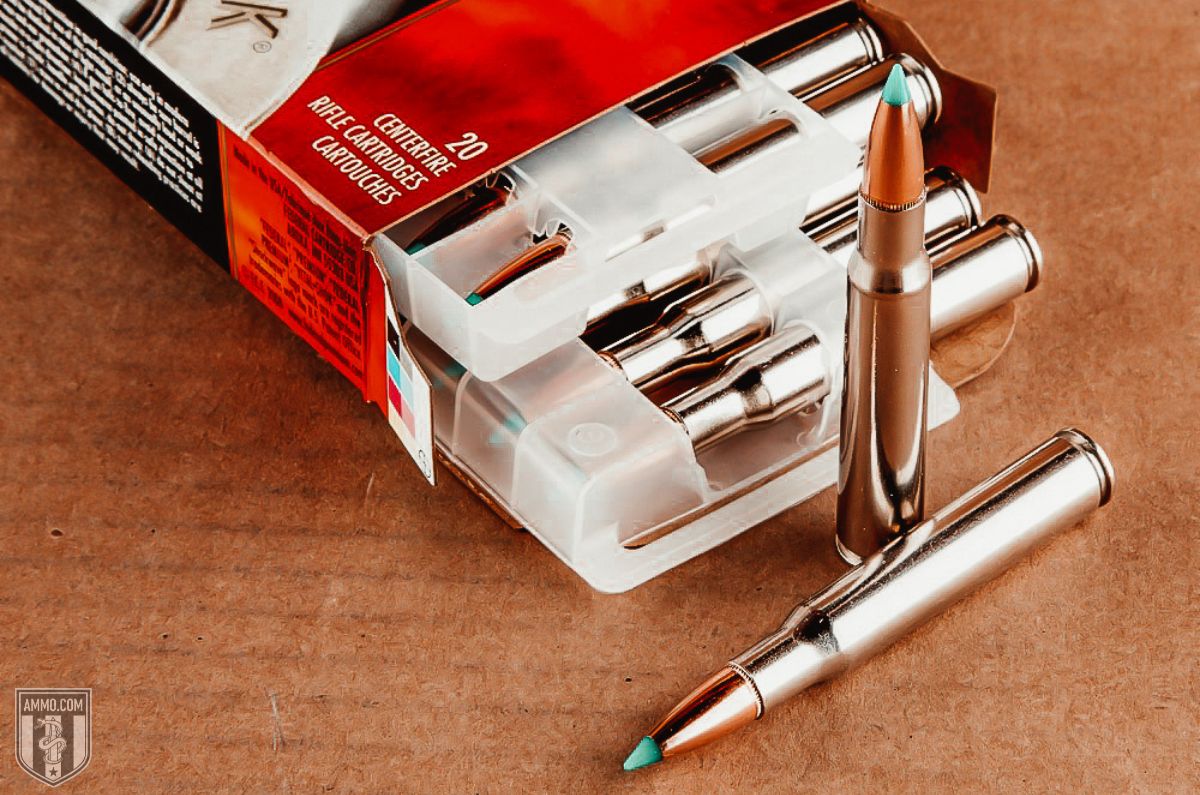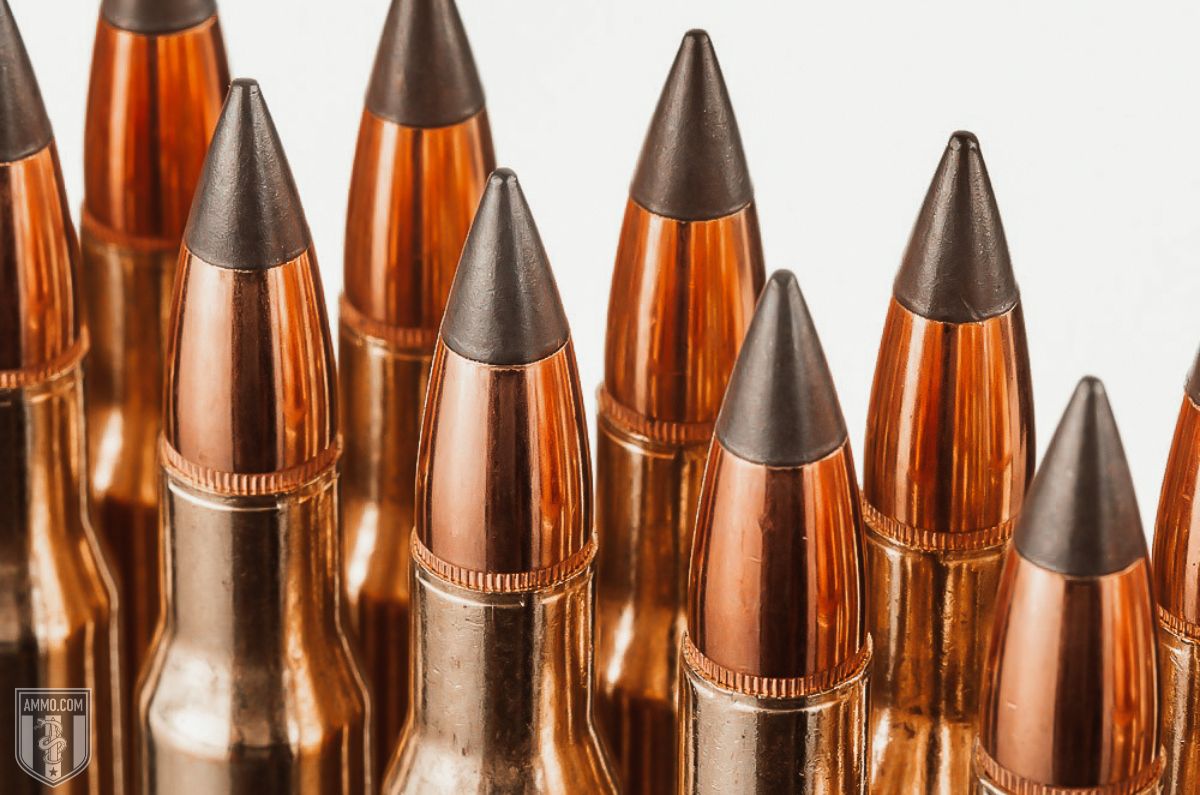450 Bushmaster vs. 30-06: Heavy-Recoil Hunting Cartridges Collide
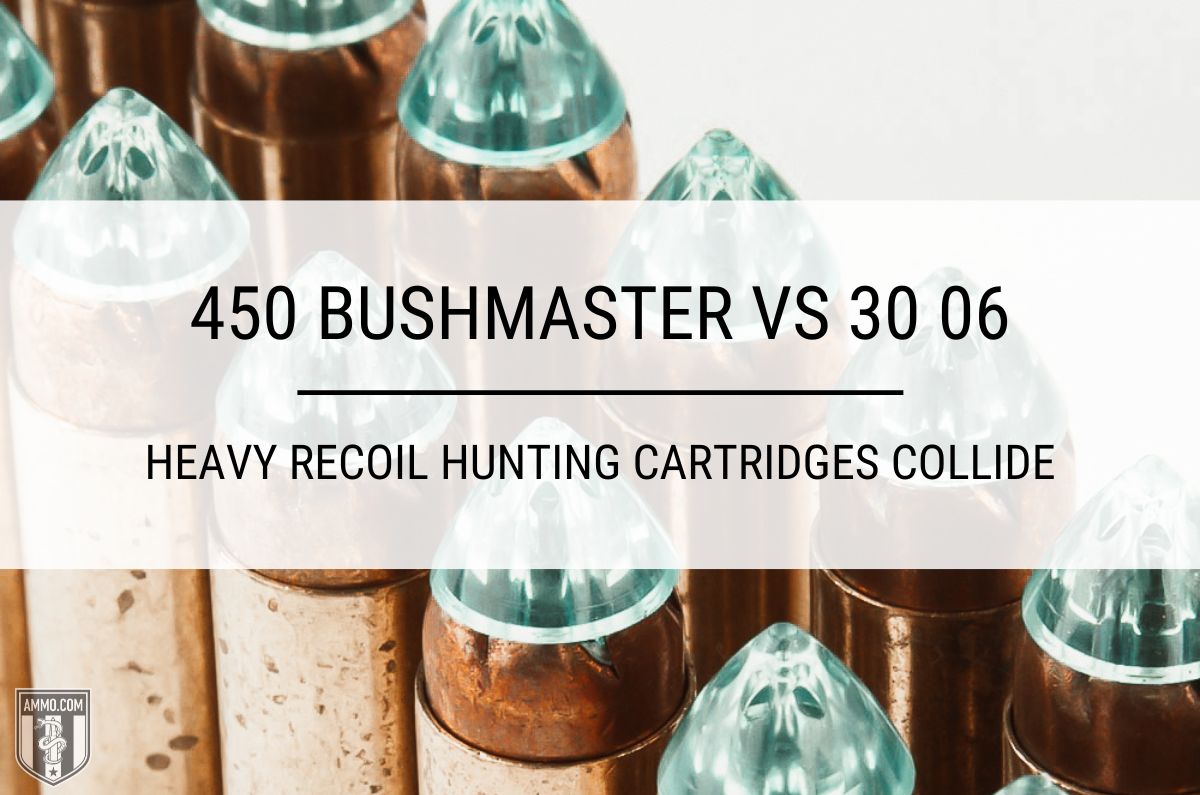
The 450 Bushmaster and 30-06 Springfield are two hard-hitting centerfire rifle cartridges that are popular for big game hunting and target shooting.
The 30-06 Springfield is nothing short of a legendary cartridge in the shooting community, having served the U.S. military during both World Wars and throughout Korea. It is the cartridge by which all other big game hunting cartridges are measured.
The 450 Bushmaster, on the other hand, is a relative newcomer to the hunting community, and transforms the AR-15 into a rifle capable of taking down a whitetail in one shot.
Although the 450 Bushmaster does an admirable job increasing the stopping power of the AR platform, 30-06 ballistics are better in virtually every category. For this reason, most hunters will stick with their tried-and-true bolt-action rifles chambered "thirty-aught."
However, the 450 Bushmaster does offer a viable semi-automatic option for hunters who live in Midwestern states where straight-walled cartridges are required for deer hunting, such as Indiana and Ohio.
In this article we will weigh the 450 Bushmaster vs. 30-06 Springfield debate to help you give you a clearer idea of which is beter for your shooting and big game hunting needs. Why? Because we like you.
What Is the Difference Between 450 Bushmaster and 30-06?
The main differences between the 450 Bushmaster and the 30-06 Springfield are their case designs and bullet diameters. The 30-06 has a more traditional bottle-neck case design and fires a 0.308” diameter bullet, whereas the 450 Bushmaster is a straight-walled cartridge that fires a much wider 0.452” diameter bullet. It's a matter of .30 cal vs. .45 cal!
Cartridge Specs
Evaluating two centerfire cartridges begins with comparing their specs.
One major difference between these two rifle cartridges are the time periods they were developed in. The 30-06 Springfield was released as the U.S. military’s answer to the 7mm Mauser in 1906. It served the U.S. Armed Forces from WWI all the way through Korea, as well as part of Vietnam (until its replacement by the 308 Winchester).
The 450 Bushmaster was designed by LeMag Firearms in 2007, and followed the "thumper concept" set forth by American shooting legend Lt. Col. Jeff Cooper. The goal of a thumper round is to increase the lethality of the AR-15 riflto the point where it can take down a whitetail deer in a single shot.
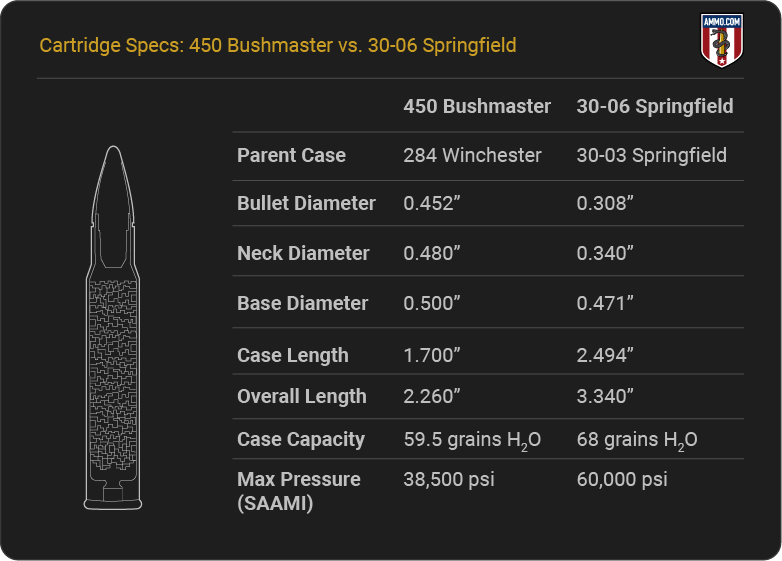
To read more about the most popular thumper rounds, check out this article: 450 Bushmaster vs. 458 SOCOM vs. 50 Beowulf.
Another major difference is the caliber of bullet either cartridge fires. The 30-06 Springfield fires the stalwart 0.308” diameter bullet; the 450 Bushmaster, a 0.452" diameter bullet.
The 30-06 can fire bullets weighing between 110 and 225 grains, with 150, 165 and 180 grains being most popular. The 450 Bushmaster fires heavier bullets ranging from 158 to 300 grains, with 250 and 260 grain bullets being most popular.
Perhaps the most obvious difference between the 450 and 30 06 are the designs of their cases. The 450 Bushmaster has a straight-walled cartridge, whereas the 30-06 has a more traditional bottle-necked case. In addition to allowing a larger charge of propellant relative to bullet diameter (and thereby boosting chamber pressure), a bottle-necked case facilitates smoother feeding than a straight-walled one.
With its case length of 2.494” and overall length (OAL) of 3.34”, the 30-06 towers over the 450 Bushmaster (1.70” case length; 2.26” overall length).
The 450 Bushmaster is constrained to a shorter OAL due to the dimensions of AR-15 magazines, which allow for a maximum OAL of 2.26”. The 30-06 is designed to fit into a standard or long action, and therefore gets away with being significantly longer.
Although the 30-06 is a taller round, the 450 Bushmaster is a bit wider: base diameter of 0.500” as opposed to 0.471”. The 30-06's larger case quite naturally grants it the larger case capacity: 68 grains, although the 450 Bushmaster's 59.5 grains isn't too pathetically far behind.
The final key difference between these two hunting cartridges are their maximum chamber pressures. Per SAAMI specs, the 30-06 can handle a considerably higher maximum pressure: 60,000 psi, as opposed to 38,500.
Recoil
Recoil is an important consideration when purchasing a new rifle, as a round with heavy recoil will be more difficult to control and slow your rate of accurate follow-up shots. The potential for flinching is also an issue for heavy-recoiling cartridges.
Felt recoil differs from shooter to shooter, and is often dependent on firearm choice, stance, and ammo. Free recoil is an objective measure of how hard a cartridge kicks, and is determined solely by firearm weight, muzzle velocity (MV), propellant weight, and bullet weight.
Although the 450 Bushmaster and 30-06 are very different in terms of maximum pressure and case capacity, both have nearly equivalent free recoil.
For the purpose of this comparison, we will consider the budget-friendly Ruger American which weighs 6.6 pounds and is available chambered for either cartridge. We'll compare two popular deer hunting cartridges: Hornady 450 BM 250gr FTX (2,200 fps MV) and Winchester 30-06 165gr Power-Point (2,800 fps MV).
Given these parameters, the 30-06 would have free recoil of 24 foot-pounds (ft-lbs); a hair less than the 450 Bushmaster's 27 ft-lbs. To put these figures into context, both rounds generate roughly the same recoil as a 12 Gauge shotguns's 1 ounce slug..
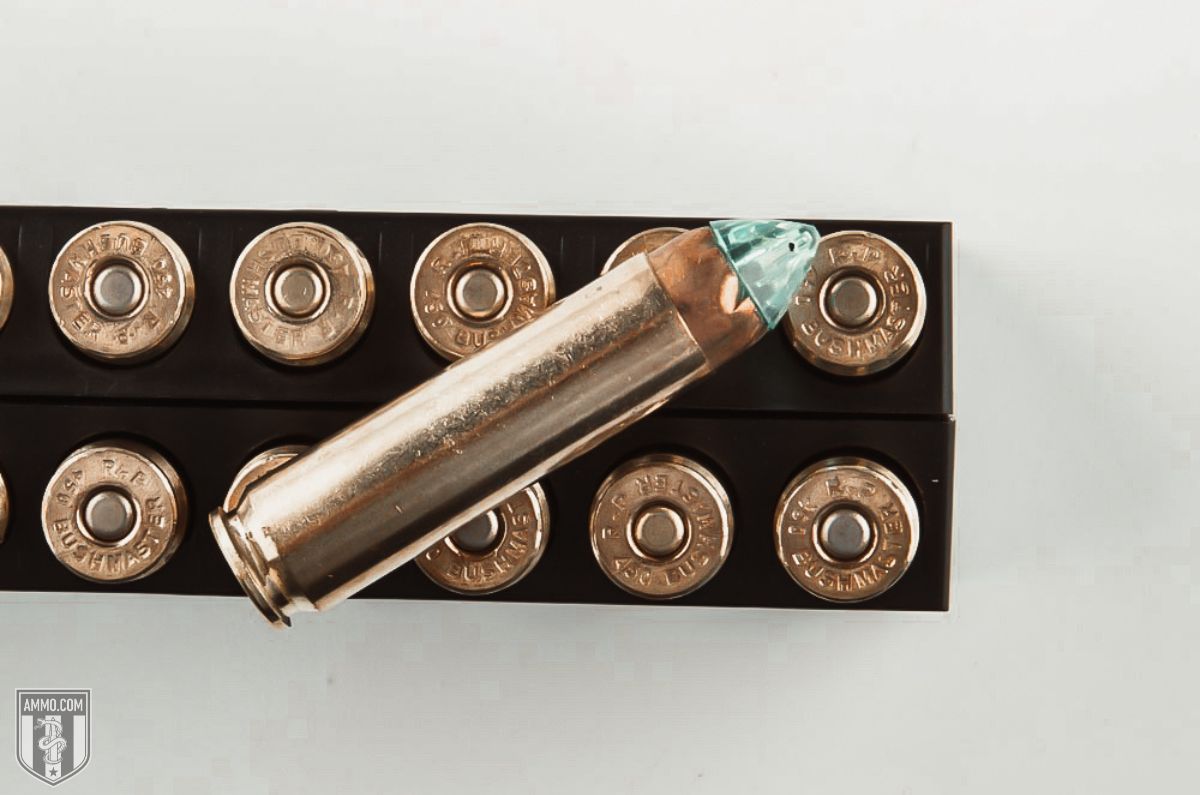
The 30-06 technically has slightly less recoil in this instance. However, if its bullet were bumped up to 180, then its recoil might very well equal that of the 450 Bushmaster.
450 Bushmaster rifles often come stock with a muzzle brake, which helps tame recoil. Muzzle brakes are considerably less common on 30-06 rifles, partly because long-range shooters don't want to forfeit any quantity of muzzle velocity.
Although the 450 Bushmaster has slightly higher recoil than the 30-06, most shooters can't tell the difference between the two.
Muzzle Velocity, Kinetic Energy, and Trajectory
If you frequent any shooting or hunting forums, the you are likely already aware that 30-06 proponents believe thier round is perfect all around. On the other hand, 450 Bushmaster supporters like to point out the round's low recoil and amazing short-range terminal ballistics.
To evaluate these claims, we will compare four of the most popular factory loads on the market and see how they stack up against each other. For 30-06 Springfield we chose Hornady 150gr SST and Winchester 180gr Ballistic Silvertip. For 450 BM, we selected Hornady 250gr FTX and Federal 300gr jacketed hollow point (JHP).
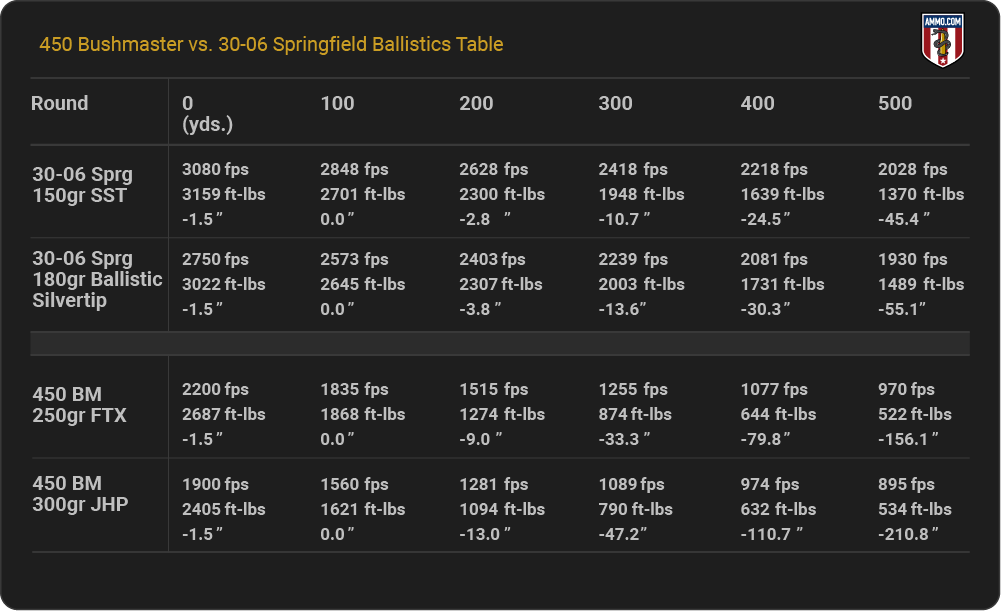
Looking at the ballistic data, we can see that the 30-06 outperforms the 450 Bushmaster in every category.
Both 30-06 bullets leave the barrel at a considerably higher velocity than the 450 Bushmaster, with the 150gr SST being the faster at 3,080 fps and the 180gr Ballistic Silvertip clocking in at 2,750 fps. The 450 BM 250gr FTX has an MV of 2,200 fps, while the 300gr JHP clears muzzle at 1,900 fps.
The 30-06 doesn't just have a higher MV. Its narrower, more aerodynamic bullet also conserves its velocity much more efficiently. Both 30-06 bullets are still supersonic (i.e. flying faster than 1,125 fps) at 500 yards, yet both 450 BM rounds had gone subsonic around 150 to 250 yards earlier.
The 30-06 continues its dominance in terms of muzzle energy. Both examples' bullets possess over 3,000 ft-lbs kinetic energy the instant they exit the barrel. The 450 BM is no slouch in this department, however. Its 250gr FTX has 2,687 ft-lbs muzzle energy; 300gr JHP, 2,405 ft-lbs.
The 30-06 conserves kinetic energy more efficiently than the 450 Bushmaster. At 500 yards, both 30-06 loads are well above the 1,000 ft-lbs (the minimum typically recommended for harvesting whitetail). In contrast, the 450 BM 300gr JHP and 250gr FTX loads dipped below 1,000 ft-lbs at around 200 yards and 250 yards respectively.
The 450 Bushmaster cannot hold a candle to the 30-06’s in terms of trajectory. At 300 yards the 30-06 dominates the 450 with almost 24” less bullet drop. The disparity only grows the farther downrange the bullets travel.
What conclusions can we draw from these ballistic data? The 30-06 Springfield ballistics clearly show that the round is designed for long-distance shooting. The 30-06 has a very flat trajectory, and fires projectiles that efexcelat conserving their velocity and kinetic energy at distance. This gives the 30-06 a longer effective range than the 450 BM.
On the other hand, the 450 Bushmaster seems to excel at shorter ranges, where it has over double the kinetic energy of a 5.56 NATO round. The 450 also has the added benefit AR-15 compatibility, whereas the 30-06 is typically fired from bolt-action rifles. That means follow-up shots are generally faster with a 450.
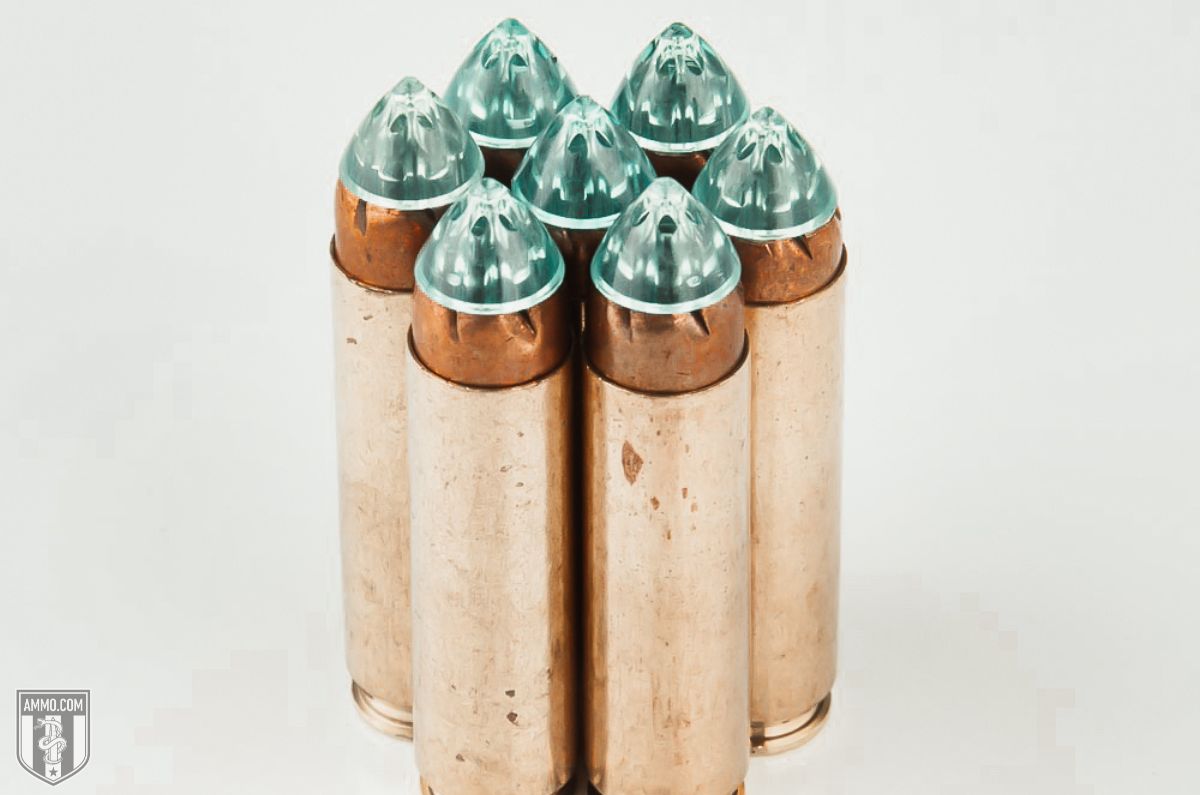
Ballistic Coefficient and Sectional Density
Ballistic coefficient (BC) is a measure of how aerodynamic a bullet is and how well it resists wind drift. Sectional density (SD) is a way to evaluate the penetration ability of a bullet based on its mass and diameter.
The 30-06 Springfield fires longer, more aerodynamic spitzer bullets, whereas the 450 Bushmaster's shorter OAL requires it to fire broader, stouter bullets. This means the 30-06 almost always has a higher BC than the 450 BM (despite the latter's heavier bullets).
Continuing our analysis of the bullets from previous section, the 150gr SST and 180gr Ballistic Silvertip 30-06 bullets have a G1 BC of 0.415 and 0.507, respectively. The 450 BM's 250gr FTX and 300gr JHP are G1 0.210 and 0.203 BC, respectively.
These massive differences show how much bullet design affects BC. The .30 caliber bullets fired by the 30-06 are more effective at fighting against wind drift and frontal air resistance than the wider .45 caliber bullets fired by the 450 Bushmaster.
In terms of sectional density, the difference between 30-06 and 450 BM is considerably closer, although the 30-06 edges out the 450 again.
Typically, smaller diameter bullets have higher penetration potential, as they can focus more of their kinetic energy into a smaller cross-sectional area. This holds true in the case of the 30-06 and 450 BM, as the 150gr SST has a SD of 0.226 – quite superior to the 250gr FTX's SD of 0.175.
Hunting
When it comes to hunting, deciding between the 30-06 and 450 BM primarily boils down to your state and local laws, as well as expected engagement ranges.
The 30-06 Springfield is the big game hunting cartridge all others are measured by. If you can use 30-06 for hunting in your area, then it will most likely prove to be the better option. The 30-06 has longer effective range and better terminal ballistics than the 450 Bushmaster.
However, all those advantages are irrelevant if you aren’t allowed to hunt with the 30-06 in your area. If you live in a state that has a straight-walled cartridge requirement for deer hunting (i.e. Pennsylvania, Ohio, Indiana, Michigan, or Illinois), then the 450 Bushmaster is the uncontested winner (unless your goal is to get fined and have your rifle confiscated).
The effective range of the 30-06 may be well north of 500 yards, although you might not get a shot any farther away than 250 in thick brush or a heavily wooded area. In other words, if you never hunt where the 30-06's long-range superiority could pose an advantage, then you'll do well enough without it.
One major benefit of the 450 Bushmaster is its adaptation to the AR-15. Having a lightweight hunting rifle with a 16" barrel makes for an easier time traversing rough terrain or thick brush.
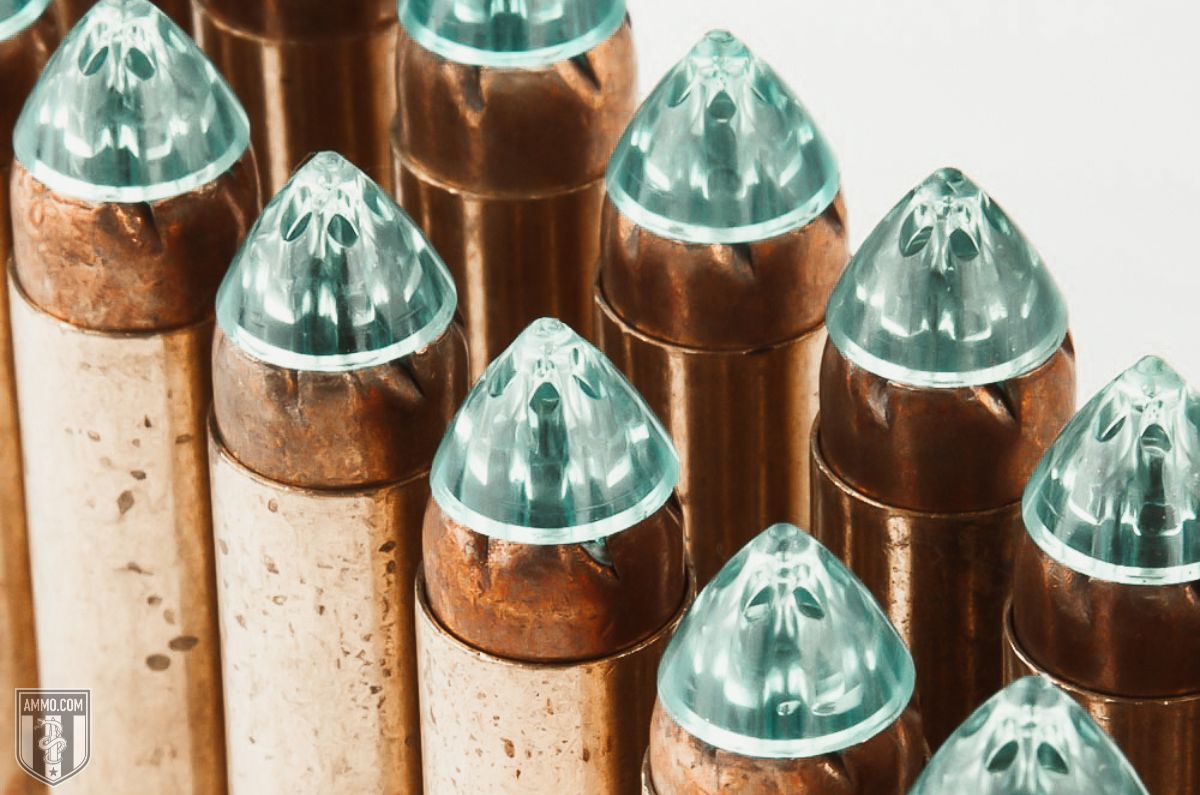
Although a heavier rifle with a standard action and longer barrel might be ideal for hunting over greater distances, it is a pain to carry on an all-day stalk through the brush.
Another benefit of the 450 Bushmaster is its semi-automatic capability. This allows for faster follow-up shots when engaging multiple game animals (e.g. hog or coyote).
This is not to say that there aren't viable semi-automatic options for the 30-06. The M1 Garand and Browning BAR are two extremely popular options for semi-auto fire with a 30-06. However, these are heavy, bulky rifles compared to the light and easy-to-wield AR.
Ammo/Rifle Cost andAvailability
When it comes to factory ammo availability and rifle options, the 30-06 Springfield is clearly the superior option.
As the 30-06 has been on the market for over a century, there are obviously a lot of different factory loads available for the cartridge. Being a two-time World War champion also hasn’t hurt the round’s popularity. After it was phased out of military service, the 30-06 transitioned perfectly into the big game hunting world.
As such, the 30-06 consistently ranks in the top three cartridges on the market when it comes to variety.
Like the 223 Rem, the 30-06 offers shooters multitude of inexpensive ammo options, including cheap FMJ practice loads and military surplus.
Although there are considerably more 30-06 ammo options available, both rounds are very close in terms of price.
At the time of writing, 30-06 FMJ ammo typically runs around $1.40/round, while top-shelf hunting ammo goes for around $2-4/round.
While it may not be nearly as popular as the 30-06, 450 Bushmaster has become one of the most popular thumper rounds on the market. It's also SAAMI certified. This has allowed multiple ammo manufacturers like Federal, Barnes, Remington, and Winchester to pick up the 450 BM. At the time of writing, inexpensive Remington UMC series FMJ ammo can be had for around $1.40/round, while hunting loads typically run around $2-3/round.
When it comes to rifle selection, there are considerably more options available for the 30-06 than almost any other round (save perhaps for 5.56/223.
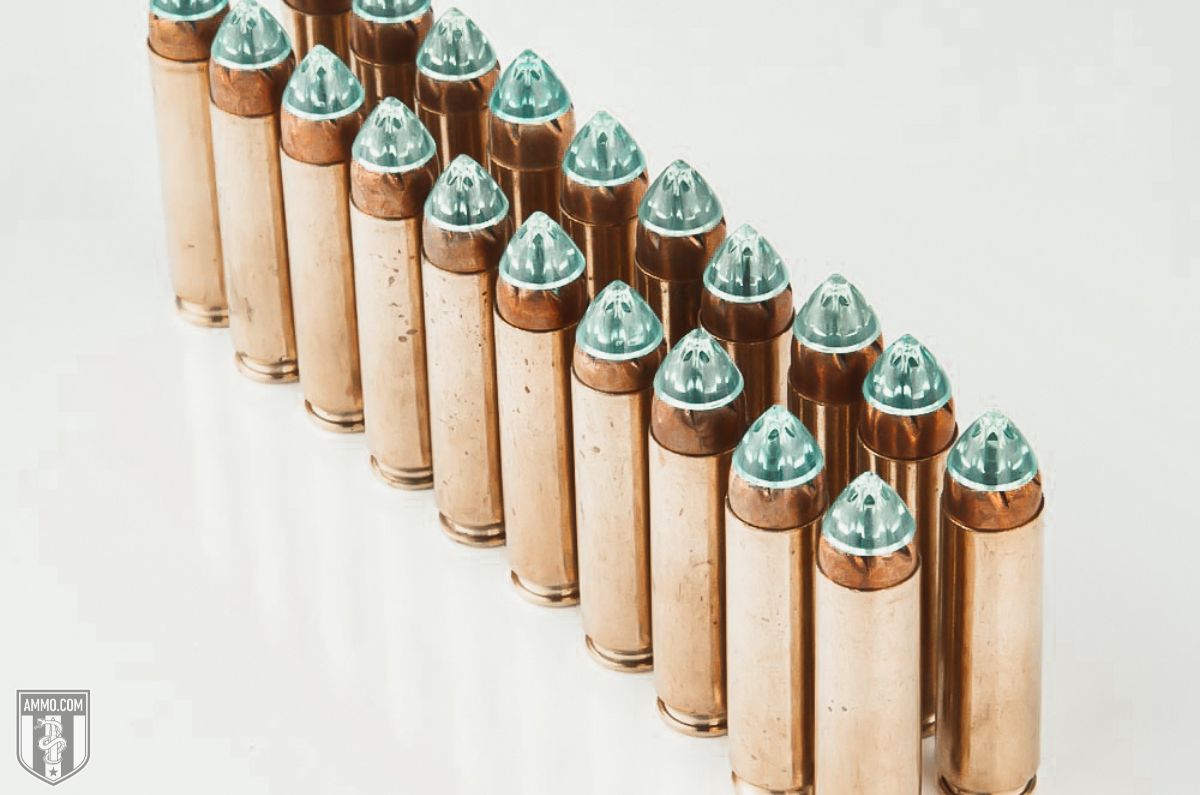
Not only do you have access to virtually every modern bolt-action hunting rifle in production – as nearly all of them are available chambered for 30-06 – but you also have access to military surplus rifles as well. The M1 Garand and 1903 Springfield are two amazing pieces of American military history that can easily double as 30-06 hunting rifles (taking care that the former requires special, lower-pressure ammo which usually isn't loaded with hunting bullets).
The AR-15 is the primary rifle chambered for 450 Bushmaster. Any 5.56 AR is a potential host for it. All that conversion requires is a barrel swap, bolt change, and single-stack magazine follower.
Several 450 Bushmaster bolt-action rifles are also available, including those made by Ruger, Bergara, Savage, Christensen, Howa, and CVA.
Reloading
Reloading is a method shooters use to reduce their overall cost per round and increase the consistency of their ammo. Better yet, handloads can be tailored to best suit both a rifle and its shooter's specific needs.
Enthusiasts have reloaded the 30-06 for decades, so there is a plethora of load data with numerous powder options at your fingertips. Load data for the 450 are also available, but can be a little trickier to locate.
The 30-06 fires the same ubiquitous 0.308” diameter bullet that is also loaded in the 308 Winchester, 300 Winchester Magnum, 300 Blackout, and 300 PRC. The 450 Bushmaster fires a 0.452” diameter bullet: the same as fired by the 45 Raptor, as well as handgun rounds like the 45 ACP and 45 Colt.
Barnes, Hornady, Nosler, Sierra, Federal, and every other major manufacturer offers several types of bullets in either caliber.
Finding 30-06 Springfield brass is typically easy, while 450 Bushmaster brass can be a little more difficult to source. As the 30-06 is a former military cartridge, there are considerably more brass cases available. (Just make sure they aren't Berdan primed before running them through your dies. To learn more about the differences between Berdan and Boxer primers, check out this article: Berdan vs Boxer Primes.)
Final Shots: 30-06 vs. 450 Bushmaster
The 30-06 Springfield and 450 Bushmaster are two hunting cartridges that can easily harvest whitetail or hogs with relative ease.
The 450 Bushmaster is a relative newcomer to the shooting world, and offers hunters in cartridge-restrictive states access to a powerful round that is designed for use in the AR-15. Combined with a muzzle brake, the 450 BM offers hunters a lightweight, semi-auto hunting rifle that works extremely well at ranges within 250 yards.
The 30-06 Springfield is the sporting cartridge by which all others are measured. It is a great all-around option for deer, elk, caribou, and bears. Its powerful flat trajectory and high striking energy make it ideal for close- or long-range shots, and loaded ammo and .30 caliber component bullets are both easy to find and relatively inexpensive.
For all intents and purposes, the 30-06 Springfield is a better round than the 450 Bushmaster, as it boasts superior ballistic performance with equal or slightly less recoil. However, for those hunters who need a straight-walled cartridge for deer hunting due to state laws, the 450 Bushmaster is a great choice.
Whichever cartridge you choose, make sure to stock up on ammunition here at Ammo.com. I’ll see you on the range!
Ammo Comparisons
- .308 vs 5.56
- 6.5 Creedmoor vs .308
- .300 Blackout vs .308
- .300 Win Mag vs .308
- .243 vs .308
- .308 vs .30-06
- 7mm-08 vs .308
- .270 vs .308
- 7.62x39 vs .308
- .223 vs .308
- .338 Lapua vs .308
- .380 ACP vs 9mm
- .223 vs 5.56
- .300 Blackout vs 5.56
- 9mm vs 45 ACP
- 9mm vs 40 S&W
- .357 SIG vs 9mm
- 10mm vs 9mm
- 9mm vs 9mm Luger
- .243 vs .270
- .300 Win Mag vs .30-06
- .270 vs .30-06
- .40 vs .45
- 38 Special vs 357
- 9mm vs 40 vs 45
- 5.56 vs 7.62x39
- 338 Lapua vs .30-06
- .30-30 vs .30-06
- 300 PRC vs 338 Lapua
- .30-06 vs 7mm
- 300 Win Mag vs 338 Lapua
- 300 PRC vs 300 Win Mag
- 300 WSM vs 300 Win Mag
- 338 Win Mag vs 338 Lapua
- 12 Gauge vs 20 Gauge
- 10mm vs 357 Mag
- .30-30 vs 7.62x39
- 224 Valkyrie vs 22-250
- 17 HMR vs 22 Mag
- 7.62x39 vs .300 Blackout
- 45 ACP vs 45 Auto
- 45-70 vs 30-30
- 300 Blackout vs 223
- 357 Magnum vs 9mm
- 350 Legend vs 300 Blackout
- 224 Valkyrie vs 223
- 45 ACP vs 38 Super
- 6.5 Grendel vs .308
- 17 HMR vs 22 LR
- 10 Gauge vs 12 Gauge
- 22-250 vs 223
- 45 Colt vs 45 ACP
- 350 Legend vs 30-30
- 5.7x28 vs 223
- 5.7 vs 9mm
- 5.56 vs 5.7
- 22 vs 9mm
- Buckshot vs Birdshot
- 450 Bushmaster vs 308
- 450 Bushmaster vs 223
- Buckshot vs Slug
- 6.5 Grendel vs 5.56 vs 223
- 6mm ARC vs 6.5 Grendel
- 44 vs 45
- 458 SOCOM vs 5.56
- 357 vs 44
- 32 ACP vs 380
- 300 Win Mag vs 338 Win Mag vs 338 Lapua Mag
- 450 Bushmaster vs 458 SOCOM vs 50 Beowulf
- 6mm Creedmoor vs 6.5 Creedmoor
- TMJ vs FMJ
- 44 Special Vs 44 Magnum
- 45 90 vs 45 70
- 6.8 Western vs 6.8 SPC
- 50 Beowulf vs 50 BMG
- 26 Nosler vs 6.5 PRC
- 28 Gauge vs 410
- 6.8 SPC vs 5.56
- 6.8 SPC vs 6.5 Grendel
- 6.8 Western vs 7mm Rem Mag vs .28 Nosler
- 6.8 Western vs 6.5 Creedmoor
- 22 Hornet vs 223
- 6.8 Western vs 6.5 PRC
- .410 vs 12 Gauge
- .410 vs 20 Gauge
- 22 LR vs 22 Mag
- 6mm ARC vs 243
- 7mm-08 vs 270
- 243 vs 6.5 Creedmoor
- Nickel vs Brass Casing
- 204 Ruger vs 223
- 50 Beowulf vs 5.56
- 260 Remington vs 6.5 Creedmoor
- 6mm Remington vs 243
- 28 Nosler vs 300 PRC
- 50 Beowulf vs 50 AE
- 22 Nosler vs 22-250
- 450 Marlin vs 45-70
- 300 Win Mag vs 300 Norma
- 458 SOCOM vs 300 Blackout
- 38-55 vs 45-70
- 22 Hornet vs 22 LR
- 300 Norma vs 338 Lapua
- 338 Lapua vs 50 BMG
- 28 Nosler vs 300 Win Mag
- 28 Nosler vs 6.5 Creedmoor
- 204 vs 22-250
- 458 SOCOM vs 45 70
- 44 40 vs 45 70
- 6.8 SPC vs 6.5 Creedmoor
- 450 Bushmaster vs 30-06
- 7mm Rem Mag vs 300 Win Mag
- 30 Carbine vs 223
- 25-06 vs 30-06
- 26 Nosler vs 28 Nosler
- 16ga vs 12ga
- 30 06 vs 7.62 x54R
- 9mm Makarov vs 9mm Luger
- 350 Legend vs 223
- 30 Carbine vs 5.56
- 6.5x55 vs 6.5 Creedmoor
- 6.5 Creedmoor vs 270 vs 25-06
- M193 vs M855
- 450 Bushmaster vs 458 SOCOM
- 6.5 Grendel vs 6.5 Creedmoor
- 350 Legend vs 5.56
- .277 Fury vs 6.8 SPC
- 277 Fury vs 300 Win Mag
- 10mm vs .45 ACP
- 277 Fury vs 223
- 6.8 SPC vs 300 Blackout
- 6.5 PRC vs 6.5 Creedmoor
- 277 Fury vs 308
- 277 Fury vs 6.5 Creedmoor
- 350 Legend vs 450 Bushmaster
- 277 Fury Vs 5.56 NATO
- 10mm vs 40S&W
- 32 ACP vs 9mm
- 32 Special vs 9mm
- 8.6 Blackout vs 300 Blackout
- 30 Super Carry vs. 9mm
- 5.56 vs 9mm
- .50 Action Express vs 9mm
- 7.62x25 vs. 9mm
- 10mm vs 44 Magnum
- 300 Blackout vs 300 Win Mag
- 6.5 Grendel vs 300 Blackout
- 460 Rowland vs 10mm
- 300 RUM vs 300 PRC
- 300 Norma vs 300 PRC
- 45 GAP vs 45 ACP
- 7mm PRC vs 300 Win Mag
- 300 PRC vs 6.5 Creedmoor
- 300 PRC vs 308
- 357 SIG vs 357 Mag
- 7.62x39 vs 7.62x51
- 243 Win vs 223 Rem
- 30 Nosler vs 300 PRC
- 6.5 Creedmoor vs. 30-06 Springfield
- 450 S&W vs. 44 Magnum
- 6.5 Creedmoor vs. 300 Win Mag
- 454 Cassull vs. 45-70 Govt
- 454 Cassull vs. 44 Mag
- 7.62x54r vs. 308 Winchester
- 22 ARC vs. 223 Rem
- Subsonic vs. Supersonic Ammo
